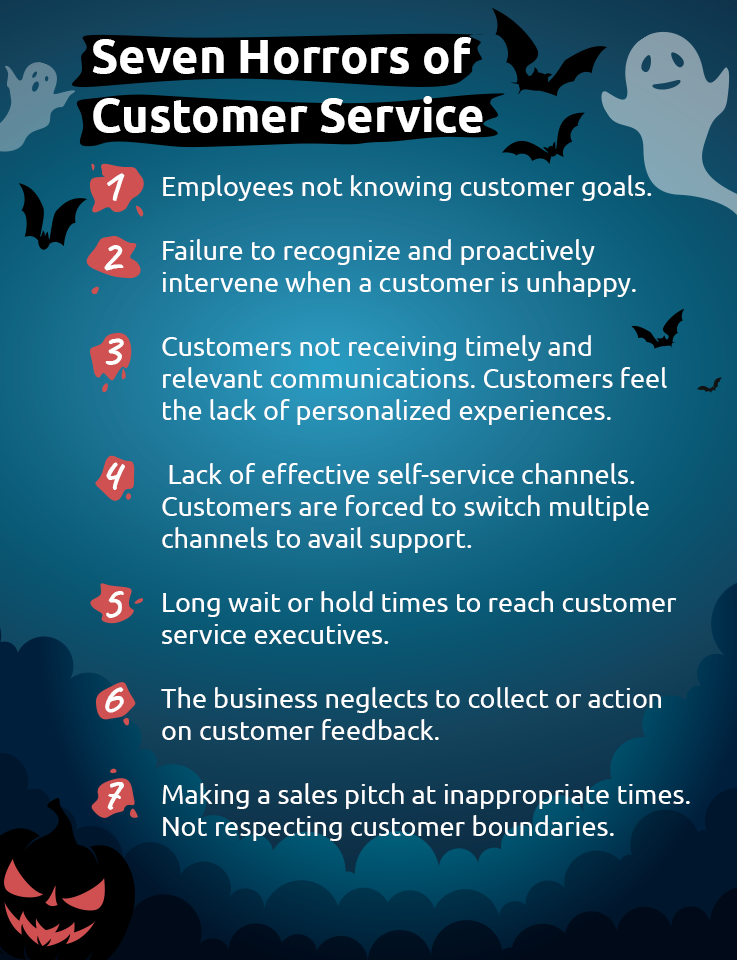Are Online Shoppers Ghosting Your Business? Here's How To Break The Jinx

Ask any entrepreneur about their biggest nightmare — customer ghosting would probably top the list. What is ghosting? Are you bewildered when perfectly happy clients suddenly go incognito or ghost your brand? What triggers such behavior? How can you prevent your customers from ghosting? Let us find out.
The New York Times describes ghosting as — when someone cuts off all communication without explanation — extending to all kinds of personal and professional relationships. Like ghosts, they vanish without any apparent warning or justification and ignore any attempts to reach out or communicate.
Those who get ghosted find the behavior extremely frustrating because it takes away the chance to correct any inadvertent error that may have occurred. It creates confusion and is probably the least-liked way of receiving closure.
Also read: Contact Center’s Secret Formula To Ensure Excellent Customer Experience
How customers ghost brands
Despite disrepute, ghosting is fairly common. Whether it is a neighborhood grocery store or a multinational corporation, customer ghosting is a common factor. But how do customers ghost businesses? How do you know if you have been ghosted?
From prospects to existing clients, anybody can ghost a business. Suppose you are in contact with a prospective client after a successful outreach. You send emails, talk to them on the phone, send product samples, and arrange demonstrations. A healthy level of interaction has been established.
Everything goes smoothly until, without warning, the prospect vanishes from your radar. No explanations. You follow up with calls, texts, and emails. However—no matter how hard you try—you just cannot reach them.
In the case of existing subscribers, you notice decreased activity, interaction, and utilization levels of your product or service. Towards the end of the billing cycle, or at the subscription renewal time, the client stops all communication. No matter how hard you try – you just cannot reach them.
You may have been ghosted if you notice such behavioral traits from your customer. In eCommerce, cart abandonment is akin to ghosting.
What triggers customers to ghost
Getting ghosted can be awkward, disheartening, and demoralizing. Ghosting can happen for a multitude of reasons. However, we list a few triggers that are commonly observed and found to cause ghosting.
1. Price of the product
One of the chief reasons why customers ghost brands are pricing. If a rival brand offers competitive pricing, customers are bound to get drawn to them. Conversely, if a brand does not intervene and offers to sweeten the existing partnership, customers will likely ghost them and be on their way to their rivals.
2. Quality
Customers' peace of mind and the quality of the product or service they opt for play a critical role. If clients find a brand’s product or service of inferior quality, they will drift away, looking for alternatives. One cannot stress the importance of quality enough. It is the foundation of customers’ relationship with brands.
If there is a quality issue, you need to stop what you are doing and go back to the drawing board—retrace your steps through your business process and fix what is wrong.
3. Service guarantee
Unreliable service and support can leave your clients high and dry. The last thing any customer wants to face is utter apathy at the hands of support agents when a problem occurs. Imagine being escorted by sales agents and then getting ghosted when interacting with support teams. Such incidents will make clients talk, and disrepute spreads like wildfire. Unfortunately, you would not know what struck you until it is too late.
4. Lack of value
Consumers always expect an exceptional experience when deciding to buy a subscription. One misstep and they will not hesitate to cancel and move toward a competitor. More than the product, the service element makes or breaks the game. It is not easy to pinpoint reasons for the lack of value, although it is probably one of the most significant causes of customer churn. At its core, lack of value means that a customer is not seeing your solution’s promised outcomes.
5. Market competition
Another cause of customers ghosting you is that they are switching over to the competition. It could be because of pricing or a better match of product features with the customer’s needs. It is crucial to keep an eye on your competitor’s (marketing, as well as customer poaching) activities and keep investing in product development to match your client’s changing needs and expectations.
6. Brand cannibalization
Many companies create different sub-brands (organizations) of the parent brand to grow its client base by targeting large numbers of clients. However, this risks taking sales from the parent company’s other products. This is known as cannibalization and can eat away at profits and destroy company value.
7. Change in client’s organizational priorities/responsibilities
There could be instances where a prospect/client is unable to communicate, likely because something even more important/urgent matter has come up that demands their attention. They are not comfortable sharing the reason with you. There is also a probability of clients not choosing to partner with brands because of differences in working style.
Sometimes, a project or process may be halted, thus ending the requirement, and the client may not want to divulge reasons. Such factors are not under your control, and the best you can do is follow up, be sincere and consistent in your customer outreach efforts, and hope they give you due attention.
8. Mismatched schedules or timing of the sales pitches are off
Crises can blow out at any time without warning. Companies tackle micro-crisis or significant organizational challenges from time to time. The reasons could be a busy time for them, a bad time for business, or even the mayhem seen in most global financial markets.
Pitching for sales to clients during a difficult time is being tone-deaf to their problems. Not only does it create a bad impression on the sales rep, but such behavior can also lead to clients opting not to do business with the brand at all—eventually blocking the brand.
9. Unrealistic planning and timelines
What happens if your client does not find your project plan and timelines to be realistic? What if your customer outreach program is simply off-key? What if there is inadequate liaising between a brand manager and a customer? Unrealistic timelines, missed deadlines, inability to honor commitments, and breaching service level agreements (SLAs) are huge red flags for clients and can trigger customers to ghost brands.

Ghosting in eCommerce
In eCommerce, ghosting means cart abandonment. Customers add items to their shopping cart but leave without completing the purchase. Cart abandonment is commonplace during the holiday season, starting from Halloween, peaking during Black Friday, and lingering until the New Year.
Cart abandonment is most commonly seen in those who are merely ‘window shopping.’ Customers add items to their cart on a whim without having actual purchase intent. These instances of customers ghosting you are unavoidable.
When customers abandon their carts before initiating the checkout process, the most likely cause for that is they encounter friction in their online shopping experience.
What causes friction in eCommerce
Multiple reasons—although we will list a few pertinent ones for ease of understanding and convenience.
- Website interface, speed, and mobile application performance issues
- Mandatory account creation, which customers see no reason to be forced to do, especially one-time purchasers
- Complicated and confusing checkout process
- Restrictions on product purchase quantity
- Unavailability of discounts or promo codes
- Unexpected or hidden shipping charges
- Unavailability of convenient and desirable payment options
- Longer than expected delivery times
- Customer-unfriendly return and refund policies
- Payment security concerns
Adopt a customer-first approach and engage customers at every touchpoint. Introduce intelligent automation in your business processes and harness the power of artificial intelligence to drive away the demons that turn customers’ experiences into nightmares. Remember, nightmarish customer experiences trigger ghosting.
Also read: What Are Customer Touchpoints – And Why They Matter
Conquer your CS demons with ThinkOwl!
It does not take long for happy customers to turn into clients from hell. Avoid customer service horrors with ThinkOwl. ThinkOwl makes your clients’ onboarding and journey with your brand memorable. Multichannel helpdesk software lets you plot your customer’s journey and empowers you to make corrections where desired. Most importantly, it helps you provide your customers with a value-driven impact. Stay prepared for the festive season with ThinkOwl. Sign up now for a 30-day free trial.












